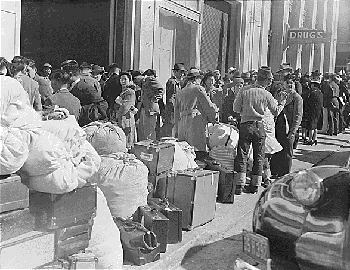![]() The Pacific War Online Encyclopedia
The Pacific War Online Encyclopedia
|
| Previous: Internal Combustion Engine Repair Ships (ARG) | Table of Contents | Next: Iowa Class, U.S. Battleships |

Internment refers to the nonjudicial confinement of persons in time of war. Enemy combatants are interned as prisoners of war, but the term is usually applied either to enemy civilians held in custody by a belligerent or to combatants held by a neutral power as required by international law.
The Second
Hague Convention spelled out duties and responsibilities of
neutral
powers in time of war. Among these was the responsibility to
intern any
land combat force that crossed into a neutral's territory.
The only neutral nations of any importance during the Pacific War
were Russia and Portugal. Both the
Allies and the Japanese largely ignored
Portugal's neutrality, and
Portugal was in no position to effectively protest. Allied troops
entered
Portuguese East Timor following
the Pearl Harbor attack
and the
Portuguese governor confined himself to his residence to
maintained the
fiction of neutrality. The Japanese
seized Portuguese East Timor in February 1942 and the surviving
Allied
troops conducted a guerrilla campaign
until
February
1943. Macau was occupied by
Japan in 1943.
Internment of civilians from enemy countries was practiced by all sides in the Second World War. However, in the United States, both Japanese nationals and most Japanese-Americans were interned. The internment of 120,000 American citizens of Japanese ancestry, on the basis of their race, has been condemned by most American historians.
Internment was not pleasant, but morbidity and mortality rates in American internment camps were not significantly different from those in the general population, suggesting that living conditions were acceptable, if somewhat Spartan. Barracks in internment camps were built to the same standards as military barracks for active duty troops (and often by the same contractors.) There were several instances of Japanese-Americans living outside the West Coast voluntarily joining their relatives in the internment camps. As the war progressed, many camp commanders gave the internees increased freedom to come and go from their camps, and some internees were able to find sponsors outside the West Coast and thereby secure their release. None of these observations are meant to condone the internment; they are meant to put the internment in perspective at a time when Germany was systematically slaughtering millions of Jews and Japan was treating civilian internees with great cruelty.
Japanese internment camps varied considerably in their harshness,
though few were as bad as Japanese prisoner of war camps.
The
mortality rate was about a third that of American prisoners of
war: Out
of 130,895 interned Allied civilians, 14,650 or 11.2 percent died
in
captivity, versus 35 percent of American POWs (Frank 1999). The
Chapei camp outside Shanghai,
which held predominantly British civilians from the International
Settlement, was possibly the least harsh civilian internment camp
run
by the Japanese. Families were kept together, there was generally
enough food to ward off
starvation, and the British civilians were even
allowed to a measure of self-government through a judicial
committee
that punished various misdemeanors. This may have been a
consequence of the fact that Chapei was run by the Japanese consul-general at Shanghai
rather than the Japanese Army.
Chapei camp was exceptional. Interned Dutch women in other camps were routinely struck by camp guards, although rape was rare. One camp commander ordered all dogs killed, and boys were forced to club their own pets to death. The greatest hardship in most camps was the lack of food, which compelled some Dutch women (estimated as about 10% on Sumatra) to trade sex for food. The ration was just 140 grams of vegetables per person by November 1944. The death rate in one internment camp was 17%, an atrocious figure but still less than in Japanese-run POW camps.
The worst of the Allied internment camps, Purama Quila outside Delhi, suffered
a death rate of about 5%, which if less than in the Japanese camps
still "reflected deplorably on British competence as well as
humanity"
(Hastings 2011). Purama Quila seems to have been the exception
rather than the rule.
References
The Avalon Project: Second Hague Convention (accessed 2008-12-4)
Frank
(1999)
Hastings
(2007, 2011)
Russell
(1958)
The Pacific War Online Encyclopedia © 2008-2009, 2012 by Kent G. Budge. Index